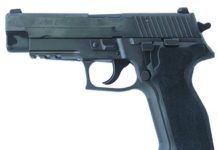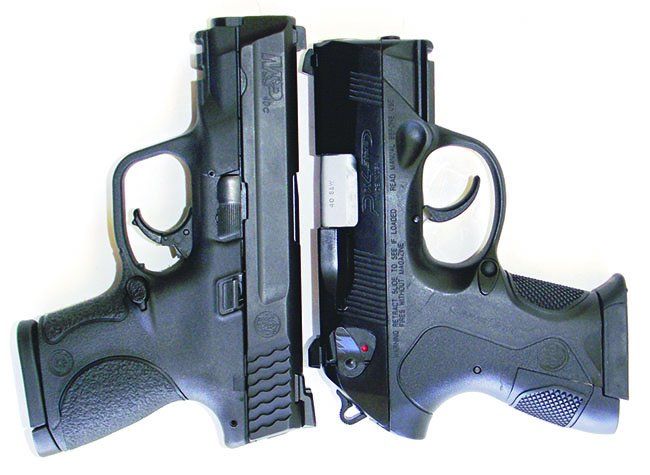
What is there to say about two 40-caliber handguns that never stuttered? A lot. There are significant differences between the handguns that lead us to believe one is the superior defensive handgun, at least for our testers. When faced with an attack by a psychopath with no sense of the moral dimension of his crime, we wish to be as well armed as possible. Unfortunately, society frowns on an individual walking around with a shotgun slung over the shoulder. Or, a full-size service pistol may become a drag on the hip. This means that the compact handgun is a popular compromise. Among the most popular concealed-carry types is the compact 40 S&W pistol.
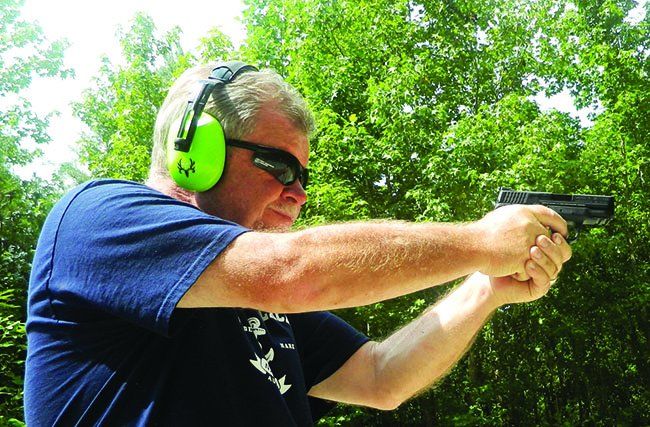
The term subcompact is applied to those handguns with both a short barrel and slide and a shortened grip, both of which have significant downsides. The shorter barrel generates less velocity. The shorter grip prevents an ideal firing grip. The smaller grip helps some shooters, but it depends upon the individual’s hands and determination in practice. So to see how these and other performance factors are handled, we looked at a pair of subcompact handguns: The Smith & Wesson Military & Police Compact M&P40c 109203 40 S&W, which lists for $569, but which we found at CheaperThanDirt.com for $480. The Beretta Px4 Storm SubCompact JXS4F20FC 40 S&W was $511, also from CTD, with a list price of $582.
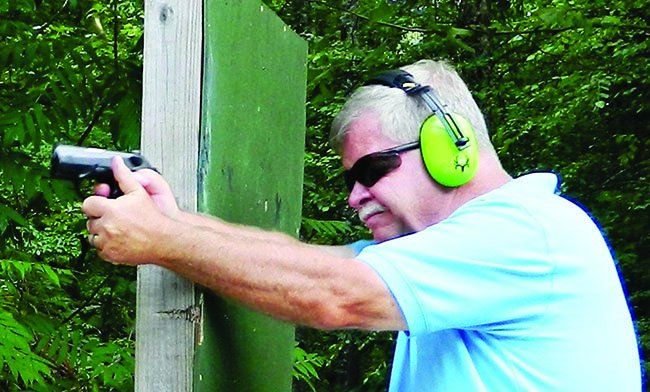
The primary difference between the two was their actions. The Smith & Wesson is a double action only. The trigger press is reset by the slide, and it is the same press for each trigger pull. The Storm features a double-action-first-shot trigger. A long press of the trigger fires the first shot. The slide cocks the hammer in recoil and the following shots are single action. Notably, the person using a double-action-first-shot handgun must learn two trigger actions. In our view, it takes less training time to master the DAO trigger, but there is an argument for the superior accuracy of the single-action trigger press.
Also notable, these 40-caliber handguns demonstrate more recoil than their 9mm counterparts, due to them expelling more bullet weight and bullet energy. In a self-defense scenario, we always want more energy on the target, if the shooter can put the bullet on the target. However, we recommend that anyone considering the 40-caliber compact handgun should take time to master the 9mm first. We found these handguns are significantly more difficult to use than 9mm compacts we’ve previously tested.
Beretta Px4 Storm SubCompact JXS4F20FC 40 S&W, $511
The Storm uses the same type of polymer frame as the Storm service pistol but it differs significantly from the larger iteration, in that the subcompact uses a tilting barrel-locked breech lockup, while the full-size Storm uses a rotating-barrel.
In the hand, our shooters found the frame was stippled in the appropriate areas for good adhesion. We didn’t think abrasion from these spots is likely to tear covering garments when the pistol is worn concealed. Like most other double-action-first-shot pistols, the Storm has a high bore axis, mainly because it takes more room to house a double-action-first-shot trigger mechanism. Therefore, we found the center line of the bore sits higher above the hand than the Smith & Wesson. Our shooters said the trigger finger must sweep downward and to the rear to properly control the trigger, but the trigger reach wasn’t overlong. We liked the curved shape, and the double-action trigger was relatively smooth at 12 pounds with no stacking. The single-action trigger press was a clean 5.5 pounds with rapid reset. The Storm featured an ambidextrous combination decocking lever and safety. When the hammer was cocked, the lever was pressed to lower the hammer without contacting the firing pin. The pistol may be carried on Safe or Fire.
The grip frame was larger than the Smith & Wesson’s, and this resulted in a larger grip and more comfort in firing. We found the grip frame fit most hands well, but some of the raters with big hands had their small fingers in a precarious grip on the frame. There were also grip inserts supplied, but the pistol fit most hands well enough. None of the raters had such a large hand that we had to change the grip insert. Also, the base pad of the magazine was an important part of the firing grip.
Elsewhere, the pistol was supplied with two 10-round magazines, and our team gave them high marks. They were well made and finished without visible weld marks. The slide was beveled at the rear. The slope of the slide angled to polished flats. There were modest forward cocking serrations. Slide-to-barrel fit was good, and the barrel was nicely crowned, we noticed.
The slide stop was slightly extended. During rapid fire and rapid magazine changes, the slide lock was handy and did not require the shooter to change his grip to actuate the slide lock. The pistol featured a light rail that is short but which still accommodated a variety of lights.
The pistol came with good combat-type sights. During firing, the traditional 3-dot sight arrangement gave good results in terms of accuracy. We thought the Storm was more comfortable to fire than the S&W, even though the higher bore axis of the Beretta resulted in more muzzle flip. This isn’t a contradiction—recoil into the hand isn’t felt as much because the muzzle rises more. During firing, beginning with the safety on and drawing from a Barber Leatherworks Chameleon holster, our time to target was acceptable, with practice. However, times were never as fast as with the Smith & Wesson, even when the draw began with the safety off with the Storm.
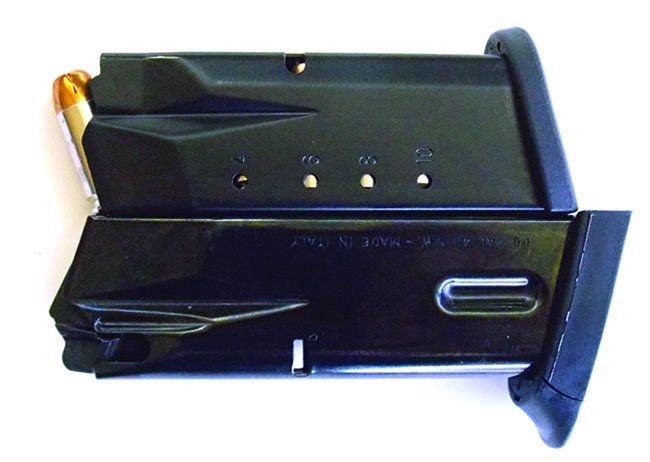
The Storm delivered good groups in rapid fire in the single-action mode, but the double-action-first-shot trigger simply wasn’t as controllable as the Smith & Wesson, in the opinion of our shooters. Firing from the benchrest at 15 yards, the Storm proved to be more accurate than the Smith & Wesson. The best group with Fiocchi’s 180-grain FMJ load was under 2 inches. This is good work for a 3-inch-barrel handgun. However, the Storm’s barrel was shorter and developed less velocity and energy. Also, the Beretta fired about 2 inches low with most loads. If this is a line-wide problem, it should be corrected by the factory, in our view.
Takedown is simple. The shooter must press a bar out of the left side of the frame to unlock the slide and barrel from the frame.
Our Team Said: The Beretta was rated down because loads shot from it struck low on target, and this should be fixed with a taller front sight. The pistol was certainly reliable and offered combat accuracy and slow-fire accuracy. The Beretta also features the better grip and is more comfortable to fire.
Smith & Wesson Military & Police Compact M&P40c 109203 40 S&W, $480
The team recently tested a Smith & Wesson M&P9c, and this pistol is dimensionally identical to that handgun. However the 40-caliber version exhibits more recoil. While recoil was heavier with the fast 155-grain loads alongside 180-grain loads, all were controllable with effort from the experienced raters. Less-experienced raters found the 40 S&W compact skirting the edge of control. The M&P40c features frame stippling that works well in giving the shooter proper grip when firing. The raters used each pistol as issued without changing the grip inserts. Large hands may need the larger insert, but this doesn’t change the fact that some hands — and not always the largest — found the small finger hanging over the bottom of the grip. One rater gave up and curled his pinky finger under the magazine rather than attempting to find purchase on the abbreviated grip. Still, we thought the grip remained comfortable despite the shorter length.
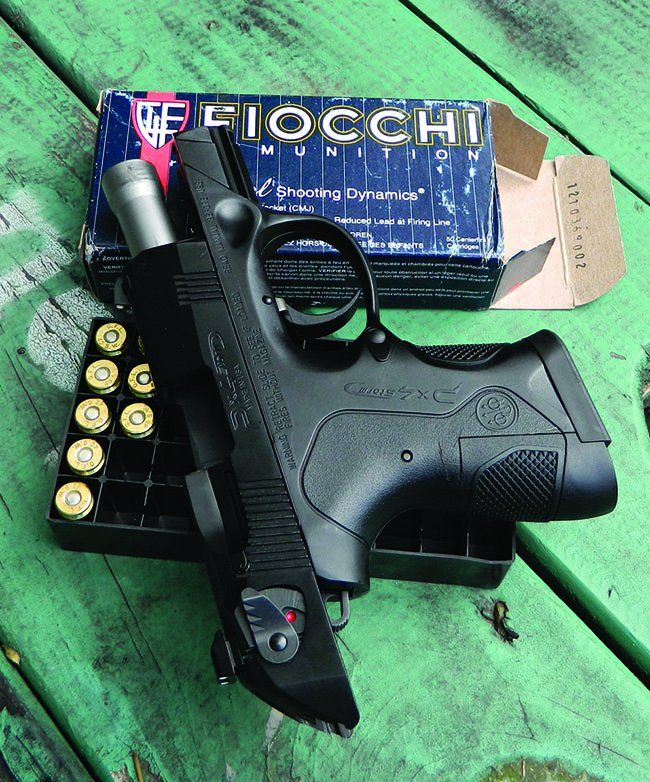
We liked the ambidextrous slide lock. While buried in the frame more than on the Beretta, it worked well in speed drills. The double-action-only trigger broke at a smooth and consistent 6.5 pounds. This trigger was controllable in rapid fire, with a rapid reset. Speed to an accurate first shot was better than the Beretta. Our shooters found this pistol to be less accurate than the 9mm version tested lately. On several occasions, the rater firing for accuracy found himself adjusting his grip due to recoil, which played into less accuracy. For accuracy shooting with pistols, we do not use a machine rest because we want our results to more closely reflect what our readers can expect with a given gun. To the best of our knowledge, there is no concealed-carry version of a Ransom Rest.
The slide was well serrated for cocking, and there were no forward cocking serrations. The sights were good combat sights. The Smith & Wesson was more concealable as a result of the short frame, but the grip does not allow a full firing grip with every hand. The Smith & Wesson’s barrel was longer than the Beretta and produced more velocity and energy. After firing the pistol extensively with three loads, there were no failures to feed, chamber, fire, or eject.
Our Team Said: The Smith & Wesson was the superior pistol in combat shooting, according to our testers. The Smith & Wesson was also lighter. For concealed carry and combat shooting, we like the Smith & Wesson based upon its work at the range, suitability for concealed carry, and simplicity of operation.
Written and photographed by Bob Campbell, using evaluations from Gun Tests team testers. GT
Beretta_PX4_Storm_JXS4F20FC_40_SW_511.pdf


























